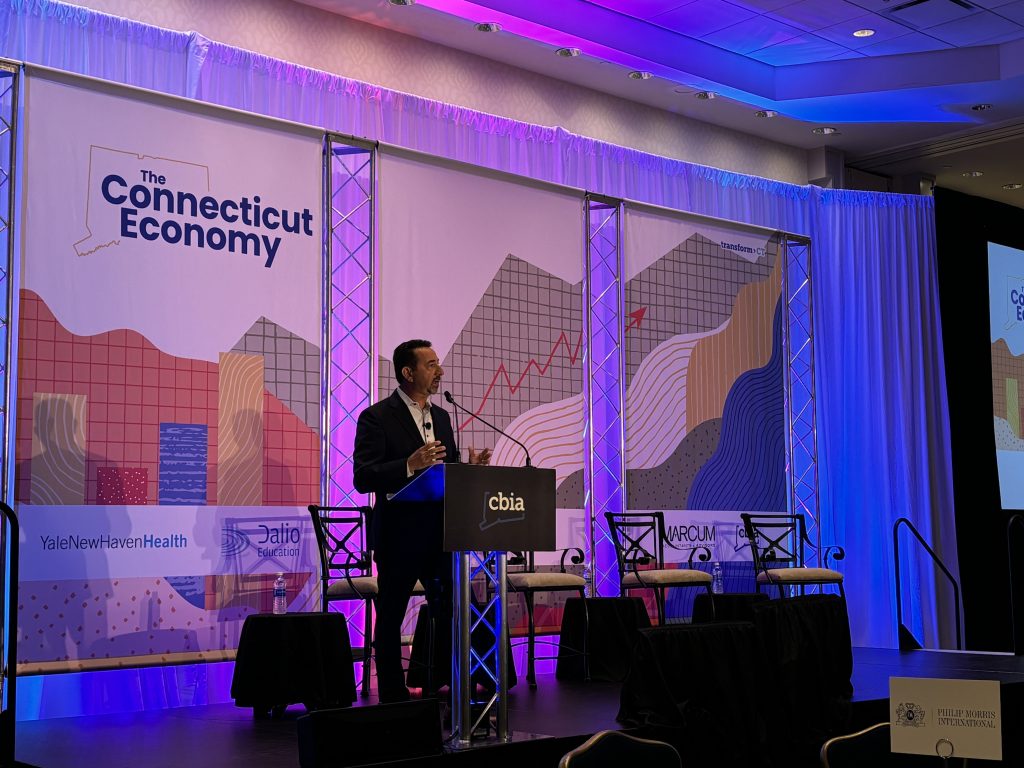Each September, members of the Connecticut Business and Industry Association — the state’s largest trade group — gather to hear the latest results of the group’s annual survey of its members.
This year’s event, which took place Wednesday morning at the Hartford Marriott downtown and drew over 400 attendees, welcomed a few unexpected voices into the fold: children’s advocates, liberal arts colleges and the state teachers’ union, Connecticut Education Association.
“It’s exciting to see them expand their universe of who they’re bringing into this work,” said Shannon Marimón, executive director of ReadyCT, an organization that prepares young people for the working world. “I’m excited about the education focus, thinking about working with the teachers union — CEA and eventually [American Federation of Teachers] — and also thinking about school systems themselves.”
The education focus is part of a new effort CBIA launched last year, the CBIA Foundation for Economic Growth and Opportunity, which is working more broadly to develop long-term policy goals and strategies for the business community. Aside from business leaders, the foundation’s board includes CEA President Kate Dias, as well as a representative from the Connecticut Conference of Independent Colleges.
Beginning earlier this year, consultants hired by the foundation hosted 30 forums around the state seeking perspectives and ideas from businesses, nonprofit organizations, children’s advocates, educational institutions, local and state officials and other community leaders. Those forums, along with earlier economic studies produced by government agencies in recent years, led to the foundation’s development of a “long-term roadmap” for business-friendly policies in four areas: workforce development, infrastructure, innovation and general business regulation. The CBIA Foundation is slated to publish that roadmap next week, and “refresh” it regularly in the years to come.
CBIA President Chris DiPentima said the association typically develops its policy priorities for each two-year legislative cycle based on the responses it receives in annual surveys of its members — like the one presented Wednesday. But, he said, “There’s a missing piece to the advocacy puzzle.”
“Connecticut lacks a long-term economic strategic plan,” DiPentima said — particularly one developed and stewarded by the business community. The annual surveys are “a snapshot in time,” he said, whereas the foundation aims to produce “a holistic response to the evolving needs of our economy.”
Marimón was enthusiastic. “Ultimately the goal is to ensure that we’re elevating all individuals to reach their fullest potential, so that they can contribute effectively to the economy and we can be a state that is very proud of that fact — and we thrive because of it.”
This year’s snapshot
Enlisting the education community could serve to address what has become a perennial issue for Connecticut businesses: finding workers.
In this year’s survey, 78% of employers reported difficulties recruiting and retaining employees. Nine out of 10 businesses said their costs are increasing, with labor costs cited as the top investment category. Respondents also cited the rapidly rising cost of health insurance — a critical component to attracting employees — as among their top challenges.
Speaking on a panel at the event Wednesday, Carolina Cavalcante, president of Tilcon Connecticut, said the company used to be able to fill the hundreds of seasonal jobs it offers on concrete and asphalt paving and construction projects relatively easily. “We usually put a lot of the jobs out in March and they’re working all the way through November,” Cavalcante said. “The past two years, we’ve had job openings that stay open throughout the whole season because we couldn’t find enough people.”
Ed Rodríguez, chief executive of label manufacturer Penmar Industries in Stratford, said his company has had particular difficulty finding entry-level workers for his shipping and handling operation. “Where do we find these individuals? It’s a frustration and it keeps coming up, because more and more we have an aging population, we have an aging workforce. Who’s going to come behind them?”
Foster Charles, founder and CEO of Charles IT, said his company worked with Central Connecticut State to find interested applicants and offered them a 90-day IT training program. The company then hires from among the program participants and provides more intensive training in their first months.
“We decided we were going to make our own funnel, because we couldn’t find it,” Charles said. “What we’re looking for is just hungry, humble and smart individuals… But finding those individuals is really the hard part.”
Cavalcante said Tilcon is working to partner directly with high schools, technical schools and the Department of Correction to identify potential hires and offer training.
The panelists also highlighted logistical hurdles — from child care to transit to housing — that can keep people from seeking work. “If you make it impossible for people to get to work, they’ll stay home,” Rodriguez said.
Later Wednesday morning, CBIA members heard from Katherine Saunders of Economic Leadership, the consultancy that worked on developing the CBIA Foundation’s policy “roadmap.”
Saunders, who has worked with several other state business groups on similar initiatives, noted that one thing that sets Connecticut apart is its highly-educated population. That’s something the state’s business leaders might need to look at in a different way in order to meet their economic goals, she said.
“We really need to explore how we can build that pipeline outside of just advanced four year degrees and beyond,” Saunders said. “There are more jobs open in this state that do not need college educations than you have people to fill them.”
Saunders was also skeptical of one of CBIA’s annual survey findings, which comes up again and again each year. CBIA members typically rank the state’s “quality of life” as the top advantage to owning and operating a business in Connecticut.
“Everyone in this room talks about the great quality of life,” she said. “If you’re not addressing housing and you’re not addressing child care, you do not have a great quality of life.”
Saunders concluded: “I want you to think about that and stay focused on the pillars of this plan.”

